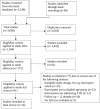A systematic review of prevention strategies for type 2 diabetes in First Nations children and young people
- PMID: 40065629
- PMCID: PMC12056536
- DOI: 10.1111/ijpo.70009
A systematic review of prevention strategies for type 2 diabetes in First Nations children and young people
Abstract
Introduction: There is a high prevalence of type 2 diabetes (T2D) in First Nations populations worldwide, increasingly at younger ages. This review aims to identify interventions for the prevention of T2D in First Nations children and young people aged 4-25 years.
Methods: A systematic search of both published and unpublished literature until March 2024 was performed using 15 electronic databases, including MEDLINE, CINAHL, EMBASE, Scopus, Cochrane Library, ATSIHealth, OpenGrey and specific First Nations databases. Eligible studies included First Nations participants aged 4-25 years without T2D, exploring interventions to prevent T2D. Outcomes included knowledge of diabetes, anthropometry and physiology, diet and nutrition, physical activity, glycemic indicators and psychosocial indicators.
Results: Fourteen pre-post exposure non-controlled studies were included, evaluating nine programs. Programs were culturally adapted and primarily school-based, focusing on individual-level behaviour modification in nutrition and physical activity. Most studies assessing knowledge outcomes reported improvement. There were inconsistent findings regarding impacts on dietary intake and glycemia. One home-based program achieved improvements across a range of outcomes, including body mass index, physical activity and psychosocial scores.
Conclusion: Despite the increasing prevalence of T2D in First Nations children and young people, evidence of effective preventive strategies within these populations remains limited.
Keywords: First Nations; children; paediatrics; systematic review; type 2 diabetes.
© 2025 The Author(s). Pediatric Obesity published by John Wiley & Sons Ltd on behalf of World Obesity Federation.
Conflict of interest statement
The authors have no conflicts of interest to disclose.
References
Publication types
MeSH terms
Grants and funding
LinkOut - more resources
Full Text Sources
Medical


